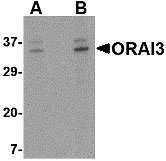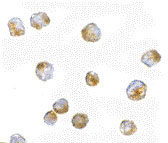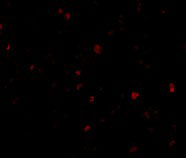ORAI3 Antibody
- 产品详情
- 实验流程
- 背景知识
Application
| WB, IF, ICC, E |
|---|---|
| Primary Accession | Q9BRQ5 |
| Other Accession | Q9BRQ5, 74732916 |
| Reactivity | Human, Mouse |
| Host | Rabbit |
| Clonality | Polyclonal |
| Isotype | IgG |
| Calculated MW | 31499 Da |
| Concentration (mg/ml) | 1 mg/mL |
| Conjugate | Unconjugated |
| Application Notes | ORAI3 antibody can be used for detection of ORAI3 by Western blot at 2 - 4 µg/mL. Antibody can also be used for immunocytochemistry starting at 5 µg/mL. For immunofluorescence start at 10 µg/mL. |
| Gene ID | 93129 |
|---|---|
| Other Names | ORAI3 Antibody: TMEM142C, TMEM142C, Protein orai-3, Transmembrane protein 142C, ORAI calcium release-activated calcium modulator 3 |
| Target/Specificity | ORAI3; ORAI3 antibody is predicted to have no cross-reactivity to ORAI1 or ORAI2. |
| Reconstitution & Storage | ORAI3 antibody can be stored at 4℃ for three months and -20℃, stable for up to one year. As with all antibodies care should be taken to avoid repeated freeze thaw cycles. Antibodies should not be exposed to prolonged high temperatures. |
| Precautions | ORAI3 Antibody is for research use only and not for use in diagnostic or therapeutic procedures. |
| Name | ORAI3 |
|---|---|
| Synonyms | TMEM142C |
| Function | Pore-forming subunit of two major inward rectifying Ca(2+) channels at the plasma membrane: Ca(2+) release-activated Ca(2+) (CRAC) channels and arachidonate-regulated Ca(2+)-selective (ARC) channels (PubMed:16807233, PubMed:17442569, PubMed:19182790, PubMed:19622606, PubMed:19706554, PubMed:20354224, PubMed:32415068). Assembles with ORAI1 and ORAI2 to form hexameric CRAC channels that mediate Ca(2+) influx upon depletion of endoplasmic reticulum Ca(2+) store and channel activation by Ca(2+) sensor STIM1, a process known as store-operated Ca(2+) entry (SOCE). Various pore subunit combinations may account for distinct CRAC channel spatiotemporal and cell-type specific dynamics. ORAI1 mainly contributes to the generation of Ca(2+) plateaus involved in sustained Ca(2+) entry and is dispensable for cytosolic Ca(2+) oscillations, whereas ORAI2 and ORAI3 generate oscillatory patterns. CRAC channels assemble in Ca(2+) signaling microdomains where Ca(2+) influx is coupled to calmodulin and calcineurin signaling and activation of NFAT transcription factors recruited to ORAI1 via AKAP5. CRAC channels are the main pathway for Ca(2+) influx in T cells and promote the immune response to pathogens by activating NFAT-dependent cytokine and chemokine transcription (PubMed:16807233, PubMed:17442569, PubMed:19182790, PubMed:19706554, PubMed:20354224, PubMed:32415068). Assembles with ORAI1 to form channels that mediate store-independent Ca(2+) influx in response to inflammatory metabolites arachidonate or its derivative leukotriene C4, termed ARC and LRC channels respectively (PubMed:19622606, PubMed:32415068). |
| Cellular Location | Cell membrane; Multi-pass membrane protein. Note=Colocalizes with STIM1 upon store depletion. |
| Tissue Location | Expressed in both naive and effector T helper cells with higher levels in effector cells. |
For Research Use Only. Not For Use In Diagnostic Procedures.
Provided below are standard protocols that you may find useful for product applications.
BACKGROUND
ORAI3 Antibody: Antigen stimulation of immune cells triggers Ca++ entry through Ca++ release-activated Ca++ (CRAC) channels. ORAI3 is one of two mammalian homologs to ORAI1, a recently identified four-transmembrane spanning protein that is an essential component of CRAC. All three homologs have been shown to function as Ca++ plasma membrane channels gated through interactions with STIM1, the store-activated endoplasmic reticulum Ca++ sensor. However, ORAI3 channels failed to produce detectable Ca++ selective currents in cells co-transfected with ORAI3 and STIM1, indicating that ORAI3 channels undergo a lesser degree of depotentiation than ORAI1 or ORAI2. Na+ currents through ORAI1, 2 and 3 channels were equally inhibited by extracellular Ca++, indicating that each have similar affinities for Ca++ within the selectivity filter.
REFERENCES
Lewis RS. Calcium signaling mechanisms in T lymphocytes. Annu. Rev. Immunol. 2001; 19:497-521.
Feske S, Gwack Y, Prakriya M, et al. A mutation in Orai1 causes immune deficiency by abrogating CRAC channel function. Nature 2006; 441:179-85.
Soboloff J, Spassova MA, Dziadek MA, et al. Calcium signals mediated by STIM and Orai proteins - a new paradigm in inter-organelle communication. Biochim. Biophys. Acta. 2006; 1763:1161-8.
Mercer JC, DeHaven WI, Smyth JT, et al. Large store-operated calcium selective currents due to co-expression of Orai1 or Orai2 with the intracellular calcium sensor, Stim1. J. Biol. Chem. 2006; 281:24979-90.
终于等到您。ABCEPTA(百远生物)抗体产品。
点击下方“我要评价 ”按钮提交您的反馈信息,您的反馈和评价是我们最宝贵的财富之一,
我们将在1-3个工作日内处理您的反馈信息。
如有疑问,联系:0512-88856768 tech-china@abcepta.com.























 癌症的基本特征包括细胞增殖、血管生成、迁移、凋亡逃避机制和细胞永生等。找到癌症发生过程中这些通路的关键标记物和对应的抗体用于检测至关重要。
癌症的基本特征包括细胞增殖、血管生成、迁移、凋亡逃避机制和细胞永生等。找到癌症发生过程中这些通路的关键标记物和对应的抗体用于检测至关重要。 为您推荐一个泛素化位点预测神器——泛素化分析工具,可以为您的蛋白的泛素化位点作出预测和评分。
为您推荐一个泛素化位点预测神器——泛素化分析工具,可以为您的蛋白的泛素化位点作出预测和评分。 细胞自噬受体图形绘图工具为你的蛋白的细胞受体结合位点作出预测和评分,识别结合到自噬通路中的蛋白是非常重要的,便于让我们理解自噬在正常生理、病理过程中的作用,如发育、细胞分化、神经退化性疾病、压力条件下、感染和癌症。
细胞自噬受体图形绘图工具为你的蛋白的细胞受体结合位点作出预测和评分,识别结合到自噬通路中的蛋白是非常重要的,便于让我们理解自噬在正常生理、病理过程中的作用,如发育、细胞分化、神经退化性疾病、压力条件下、感染和癌症。








